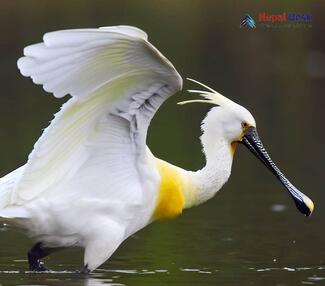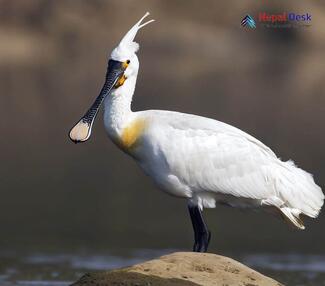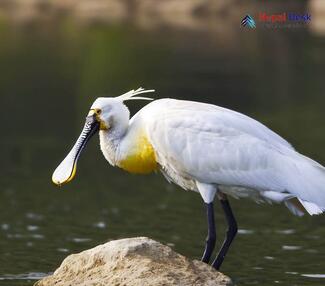With over 900 recorded species of birds, Nepal is home to a diverse array of avian life. Among these Eurasian Spoonbill (Platalea leucorodia) stands out as one of the most fascinating and unique birds. Also Known as the Common Spoonbill, it is a wading bird of the ibis and spoonbill family Threskiornithidae. The genus name Platalea is from Latin and means "broad", referring to the distinctive shape of the bill, and leucorodia is from Ancient Greek leukerodios "spoonbill", itself derived from leukos. In England, it was traditionally known as the "shovelard", a name later used for the Northern Shoveller. The Eurasian spoonbill has three subspecies namely P. l. leucorodia, P. l. balsaci and P. l. archeri.
Being a rare sight in Nepal, spotting a Eurasian Spoonbill is both a thrilling and magical experience. Let's further look at the various facts of this fascinating creature:
What makes the Eurasian Spoonbill so special?
The Eurasian Spoonbill is easily distinguishable from other wading birds due to its remarkable spoon-shaped bill. This flattened, spoon-like tip allows the bird to efficiently sweep its bill back and forth through shallow waters to catch small fish, insects, and amphibians. Sporting an elegant white plumage with traces of yellow near the chest area and black wingtips that are visible during flight, the Eurasian Spoonbill is highly appealing to bird enthusiasts.
Where can you find them in Nepal?
Though rare sightings, the Eurasian Spoonbill has been spotted in various wetlands across Nepal. Prime locations include Koshi Tappu Wildlife Reserve, Jagdishpur Reservoir, and Ghodaghodi Lake – all significant ecosystems that offer vital resting and feeding sites for migratory birds. Bird enthusiasts visiting these areas between October and March have higher chances of witnessing this majestic creature during its winter migration period.
Conservation efforts for the Eurasian Spoonbill
Like many other species, the Eurasian Spoonbill is threatened by habitat loss due to human encroachment and pollution. Thankfully, conservation efforts such as the Ramsar Sites designation have played a crucial role in protecting essential wetland habitats across Nepal. Bird conservation organizations within the country also work tirelessly to educate local communities on preserving these precious resources for future generations.
In conclusion, the Eurasian Spoonbill is an extraordinary bird species, and witnessing one in Nepal is a memory to be treasured. Their unique appearance and feeding behavior captivate bird enthusiasts and inspire ongoing conservation efforts. By supporting local habitat preservation and species protection initiatives, we can ensure the Eurasian Spoonbill continues to grace the skies and waters of Nepal for years to come. So next time you're on a birdwatching adventure in Nepal, keep an eye out for this enchanting inhabitant—a rare, magical experience awaits!




